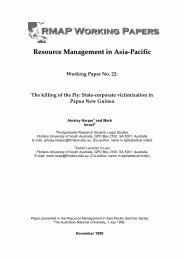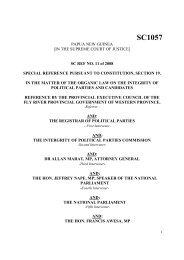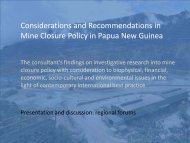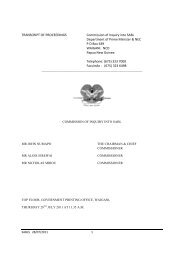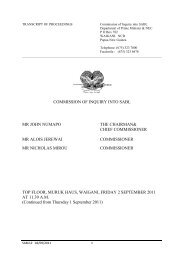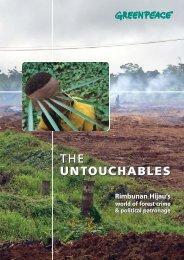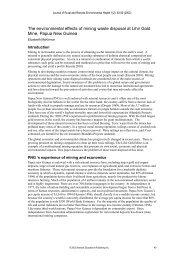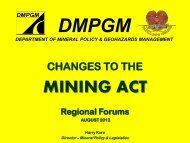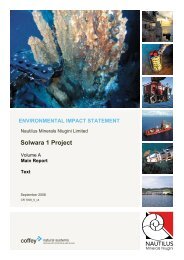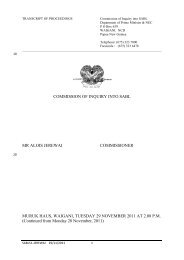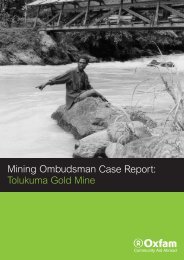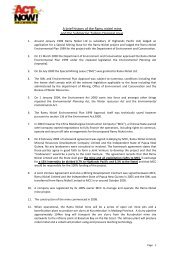Fishy business. The Social Impact of SST.pdf - Act Now!
Fishy business. The Social Impact of SST.pdf - Act Now!
Fishy business. The Social Impact of SST.pdf - Act Now!
You also want an ePaper? Increase the reach of your titles
YUMPU automatically turns print PDFs into web optimized ePapers that Google loves.
• Monitor interactions between the licensed tuna fishery and other users <strong>of</strong> theresource, and where necessary, implement measures to address any adverseimpacts;• Monitor the economic performance <strong>of</strong> the tuna fishery, including informationon catches, sales, processing and other relevant information from both thecatching and processing sectors;• Implement a strategy for responsible fishing, as required under internationalor regional conventions to which PNG is a party;• Facilitate ongoing consultations on management arrangements.<strong>The</strong> actual measures applied depend on the gear type:<strong>The</strong> main management measures for longlining are: (1) Licences only to Papua NewGuinea registered and flagged vessels and locally-based foreign fishing vesselsoperated by Papua New Guinea companies, (2) <strong>The</strong> total number <strong>of</strong> longline tunafishing vessels to be licensed shall be 100, (3) Locally-based foreign longline vesselswill not be granted licences to operate as freezer vessels, (4) <strong>The</strong> total allowablecatch for the tuna longline fishery in the fisheries waters <strong>of</strong> Papua New Guinea is tobe 10,000 metric tonnes per annum, and (5) Fishing using longline gear is prohibitedin areas within 12 miles from any land or island or declared reef.<strong>The</strong> main management measures for purse seining are: (1) <strong>The</strong> total number <strong>of</strong>purse seine fishing vessels to be licensed shall be 100, (2) <strong>The</strong> total allowable catchfor the tuna purse seine fishery in the fisheries waters <strong>of</strong> Papua New Guinea shall be300,000 mt per annum, (3) Only vessels with carrying capacity <strong>of</strong> 600 mt or lessmay operate with motherships within the PNG fisheries zone, (4) All fish taken bylocally based foreign vessels within the EEZ and on the High Seas must be landed inPNG for processing or transshipped as PNG export from a designated port, (5) Inaddition to the licence fee prescribed in the Regulations, there shall be a charge forlocally-based foreign vessels for access to the tuna resource, (6) Locally-basedforeign purse seine fishing vessels on charter and foreign-based foreign vessels arenot to fish in the Territorial Seas or Archipelagic Waters, and (7) Access is strictlyprohibited, unless stated otherwise in the terms <strong>of</strong> the licence, twelve miles from anyland, island or declared reef.<strong>The</strong> main management measures for pole-and-line fishing are: (1) <strong>The</strong> total number<strong>of</strong> pole-and-line tuna vessels that will be licensed to operate in the fishery will be 30,(2) <strong>The</strong> TAC shall be 20,000 mt, (3) Areas where access is strictly prohibited, unlessstated otherwise in the terms <strong>of</strong> the licence, are any less than twelve miles from anyland, island or declared reef.<strong>The</strong> measures have been reasonably effective in attaining the objectives which havebeen set. In terms <strong>of</strong> specific progress, one <strong>of</strong> the greatest successes is that thenumber <strong>of</strong> locally-based longliners (and associated employment and other benefits)has increased remarkably since the National Tuna Fishery Management Plan wasformulated. With respect to purse seining, the number <strong>of</strong> licenses issued hasremained under the stipulated cap. Because there is presently no pole-and-line tunafishing in PNG, it is not possible to evaluate the management measures applied. In211



